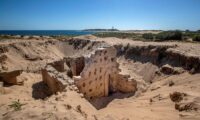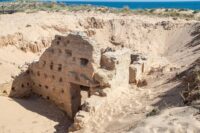 The remains of a Roman bath from the 4th century have emerged from the dunes of Cape Trafalgar near Cádiz, on the southwest coast of Spain. Roman buildings in any condition are rare survivals in Cádiz because the ancient city, founded by Phoenicians 3,100 years ago, was destroyed during the Visigothic conquest of southern Spain in 410 A.D., and this building is unusually well-preserved by the winds that quickly buried it in sand after it was abandoned.
The remains of a Roman bath from the 4th century have emerged from the dunes of Cape Trafalgar near Cádiz, on the southwest coast of Spain. Roman buildings in any condition are rare survivals in Cádiz because the ancient city, founded by Phoenicians 3,100 years ago, was destroyed during the Visigothic conquest of southern Spain in 410 A.D., and this building is unusually well-preserved by the winds that quickly buried it in sand after it was abandoned.
The surviving walls are 13 feet high (the remains of Roman structures are typically foundations and short walls no more than two feet high) and contain numerous windows and doors. There are fragments of the red, white and black stucco used to decorate the walls, as well as marble cladding.
“It is a structure that has an exceptional state of conservation for the Iberian Peninsula and the western Mediterranean in general,” Darío Bernal, a professor of archaeology at the University of Cádiz, tells Efe. […]
Bernal and his team believe the building was a sophisticated rural bath complex complete with an oven-fueled hot air current that warmed the walls and floors.
It most likely served as a communal hot bath for local workers, many of whom would have toiled away in odorous coastal jobs like fish farming and salting.
 Indeed, the archaeology team was exploring the site as part of a research project investigating the history of Roman aquaculture in the area. When the structure first emerge, Bernal thought it was a cetaria, a fish pond connected to the sea where fish and crustaceans were fattened up. Wealthy Romans attached these nurseries to their estates so they had a constant supply of the best fish for their own consumption and to sell.
Indeed, the archaeology team was exploring the site as part of a research project investigating the history of Roman aquaculture in the area. When the structure first emerge, Bernal thought it was a cetaria, a fish pond connected to the sea where fish and crustaceans were fattened up. Wealthy Romans attached these nurseries to their estates so they had a constant supply of the best fish for their own consumption and to sell.
Fishing and fish products were the main industry in this area during the Roman era. What is now Cádiz was a major producer of garum, the sauce made of crushed and fermented fish intestines that was consumed in prodigious quantities by people from every walk of life all over the Roman empire. The garum from the Hispania Baetica province was considered the best, and the remains of garum factories have been found in Cádiz and other towns along the coast.
Local authorities are now considering what to do with the dune baths once excavations are complete. One possibility is to maintain it as an archaeological park to attract tourism. The other is just to let the wind do its thing and bury it back in the sand for its own protection.